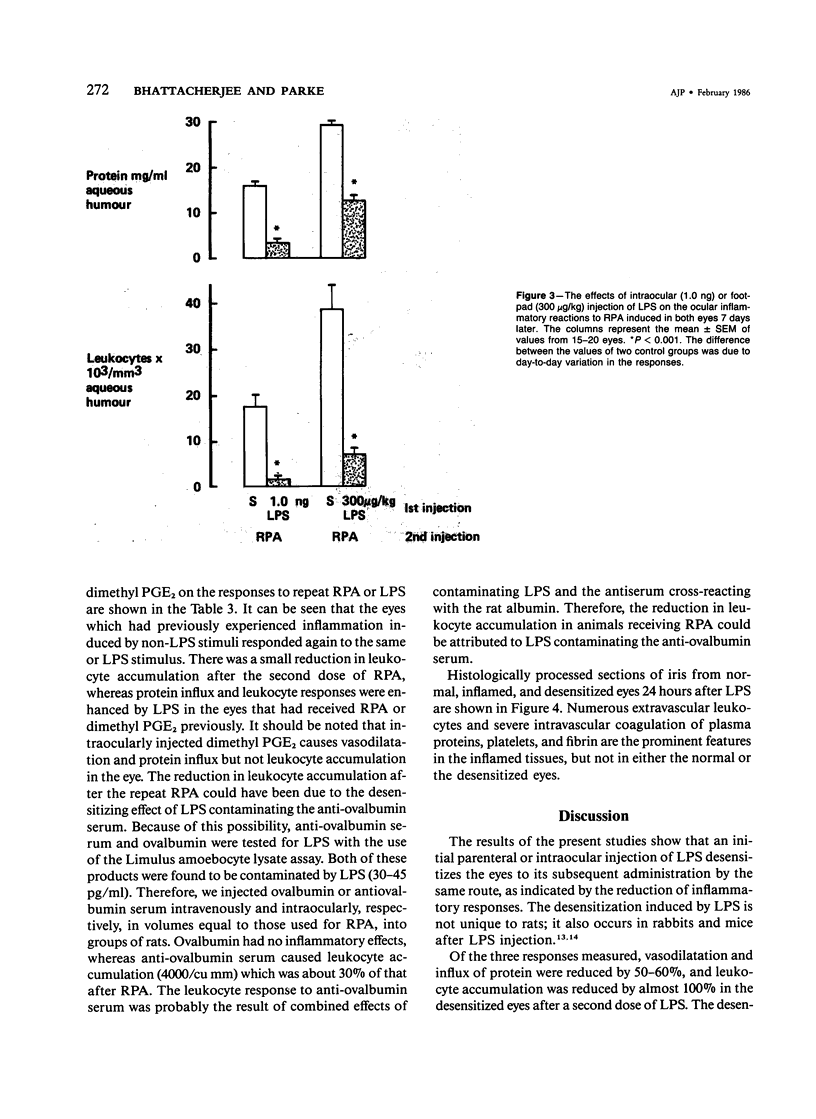Abstract
The development of tolerance induced by subcutaneous or intraocular injections of lipopolysaccharide (LPS, Escherichia coli) in rat eyes has been studied. In addition, the ocular inflammatory responses to the reversed passive Arthus (RPA) reaction in the tolerant eyes were investigated. The tolerance in the eye after a single injection of LPS persisted for at least 42 days. Up to 42 days, vasodilatation, disruption of the blood-aqueous barrier, and leukocyte accumulation in the anterior chamber after a second injection of LPS were inhibited. Unilateral intraocular injection of LPS produced local tolerance, which was not observed in the contralateral eyes. The inflammatory reactions in response to RPA in the LPS-tolerant eyes were also significantly attenuated. It was also found that inflammatory reactions induced by RPA or 16,16-dimethyl prostaglandin E2 had no inhibitory effect on the responses to subsequent RPA or LPS administration, which indicated that initial inflammatory reactions do not render the tissues refractory to the response to a second stimuli. The results of this study suggest that some, as yet unknown, local changes in the ocular tissues caused by LPS may be involved in the development of tolerance.
Full text
PDF








Images in this article
Selected References
These references are in PubMed. This may not be the complete list of references from this article.
- BENNETT I. L., Jr, CLUFF L. E. Bacterial pyrogens. Pharmacol Rev. 1957 Dec;9(4):427–479. [PubMed] [Google Scholar]
- Beller F. K. The role of endotoxin in disseminated intravascular coagulation. Thromb Diath Haemorrh Suppl. 1969;36:125–149. [PubMed] [Google Scholar]
- Bhattacherjee P. Release of prostaglandin-like substances by Shigella endotoxin and its inhibition by non-steroidal anti-inflammatory compounds. Br J Pharmacol. 1975 Aug;54(4):489–494. doi: 10.1111/j.1476-5381.1975.tb07595.x. [DOI] [PMC free article] [PubMed] [Google Scholar]
- Bhattacherjee P., Williams R. N., Eakins K. E. An evaluation of ocular inflammation following the injection of bacterial endotoxin into the rat foot pad. Invest Ophthalmol Vis Sci. 1983 Feb;24(2):196–202. [PubMed] [Google Scholar]
- Bito L. Z. The effects of experimental uveitis on anterior uveal prostaglandin transport and aqueous humor composition. Invest Ophthalmol. 1974 Dec;13(12):959–966. [PubMed] [Google Scholar]
- Colditz I. G., Movat H. Z. Desensitization of acute inflammatory lesions to chemotaxins and endotoxin. J Immunol. 1984 Oct;133(4):2163–2168. [PubMed] [Google Scholar]
- Cooper P. H., Mayer P., Baggiolini M. Stimulation of phagocytosis in bone marrow-derived mouse macrophages by bacterial lipopolysaccharide: correlation with biochemical and functional parameters. J Immunol. 1984 Aug;133(2):913–922. [PubMed] [Google Scholar]
- Greisman S. E., Young E. J., Carozza F. A., Jr Mechanisms of endotoxin tolerance. V. Specificity of the early and late phases of pyrogenic tolerance. J Immunol. 1969 Dec;103(6):1223–1236. [PubMed] [Google Scholar]
- Hammond B. R., Bhattacherjee P. A method for the intraocular injection of micro-volumes in small animal species. Curr Eye Res. 1981;1(11):683–685. doi: 10.3109/02713688109001873. [DOI] [PubMed] [Google Scholar]
- Howes E. L., Jr, Aronson S. B., McKay D. G. Ocular vascular permeability. Effect of systemic administration of bacterial endotoxin. Arch Ophthalmol. 1970 Sep;84(3):360–367. doi: 10.1001/archopht.1970.00990040362017. [DOI] [PubMed] [Google Scholar]
- Howes E. L., Jr, Goldyne M. E., Perez H. D., Goldstein I. M., Rosenbaum J. T. Lipopolysaccharide tolerance inhibits eye inflammation. I. Reduced immune complex or lipopolysaccharide effects. Arch Ophthalmol. 1985 Feb;103(2):257–260. doi: 10.1001/archopht.1985.01050020109031. [DOI] [PubMed] [Google Scholar]
- Howes E. L., Jr, Rosenbaum J. T. Lipopolysaccharide tolerance inhibits eye inflammation. II. Preliminary studies on the mechanism. Arch Ophthalmol. 1985 Feb;103(2):261–265. doi: 10.1001/archopht.1985.01050020113032. [DOI] [PubMed] [Google Scholar]
- Kaku M., Yagawa K., Nagao S., Tanaka A. Enhanced superoxide anion release from phagocytes by muramyl dipeptide or lipopolysaccharide. Infect Immun. 1983 Feb;39(2):559–564. doi: 10.1128/iai.39.2.559-564.1983. [DOI] [PMC free article] [PubMed] [Google Scholar]
- LOWRY O. H., ROSEBROUGH N. J., FARR A. L., RANDALL R. J. Protein measurement with the Folin phenol reagent. J Biol Chem. 1951 Nov;193(1):265–275. [PubMed] [Google Scholar]
- MEIER R., BEIN H. J., JAQUES R. The action of bacterial polysaccharides on allergic phenomena. Int Arch Allergy Appl Immunol. 1957;11(1-2):101–118. doi: 10.1159/000228406. [DOI] [PubMed] [Google Scholar]
- Morland B., Kaplan G. Macrophage activation in vivo and in vitro. Exp Cell Res. 1977 Sep;108(2):279–288. doi: 10.1016/s0014-4827(77)80035-9. [DOI] [PubMed] [Google Scholar]
- Peavy D. L., Baughn R. E., Musher D. M. Strain-dependent cytotoxic effects of endotoxin for mouse peritoneal macrophages. Infect Immun. 1978 Jul;21(1):310–319. doi: 10.1128/iai.21.1.310-319.1978. [DOI] [PMC free article] [PubMed] [Google Scholar]
- Rosenbaum J. T., Hartiala K. T., Webster R. O., Howes E. L., Jr, Goldstein I. M. Antiinflammatory effects of endotoxin. Inhibition of rabbit polymorphonuclear leukocyte responses to complement (C5)-derived peptides in vivo and in vitro. Am J Pathol. 1983 Dec;113(3):291–299. [PMC free article] [PubMed] [Google Scholar]
- Rosenbaum J. T., McDevitt H. O., Guss R. B., Egbert P. R. Endotoxin-induced uveitis in rats as a model for human disease. Nature. 1980 Aug 7;286(5773):611–613. doi: 10.1038/286611a0. [DOI] [PubMed] [Google Scholar]
- Russo M. The role of macrophages in the chemotactic response of polymorphonuclear leukocytes to bacterial lipopolysaccharides. Proc Soc Exp Biol Med. 1980 Jul;164(3):326–330. doi: 10.3181/00379727-164-40871. [DOI] [PubMed] [Google Scholar]
- Snell E. S., Atkins E. Interactions of gram-negative bacterial endotoxin with rabbit blood in vitro. Am J Physiol. 1967 May;212(5):1103–1112. doi: 10.1152/ajplegacy.1967.212.5.1103. [DOI] [PubMed] [Google Scholar]
- Snyderman R., Phillips J. K., Mergenhagen S. E. Biological activity of complement in vivo. Role of C5 in the accumulation of polymorphonuclear leukocytes in inflammatory exudates. J Exp Med. 1971 Nov 1;134(5):1131–1143. doi: 10.1084/jem.134.5.1131. [DOI] [PMC free article] [PubMed] [Google Scholar]
- Sultzer B. M. Genetic control of leucocyte responses to endotoxin. Nature. 1968 Sep 21;219(5160):1253–1254. doi: 10.1038/2191253a0. [DOI] [PubMed] [Google Scholar]
- Verghese M. W., Snyderman R. Differential anti-inflammatory effects of LPS in susceptible and resistant mouse strains. J Immunol. 1981 Jul;127(1):288–293. [PubMed] [Google Scholar]
- Wahl L. M., Wahl S. M., Mergenhagen S. E., Martin G. R. Collagenase production by endotoxin-activated macrophages. Proc Natl Acad Sci U S A. 1974 Sep;71(9):3598–3601. doi: 10.1073/pnas.71.9.3598. [DOI] [PMC free article] [PubMed] [Google Scholar]
- Wyler F., Forsyth R. P., Nies A. S., Neutze J. M., Melmon K. L. Endotoxin-induced regional circulatory changes in the unanesthetized monkey. Circ Res. 1969 Jun;24(6):777–786. doi: 10.1161/01.res.24.6.777. [DOI] [PubMed] [Google Scholar]



